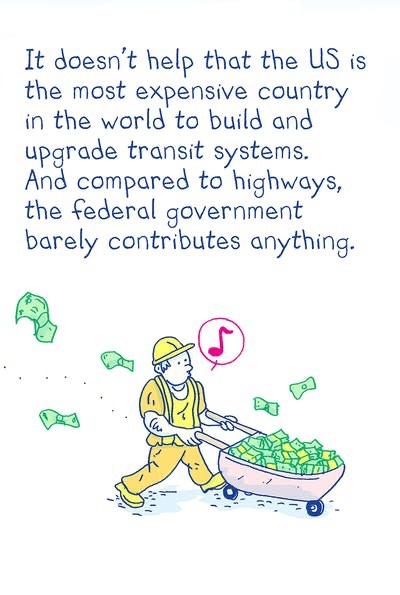A few years ago, I did some freelance transportation reporting. I wrote about topics like bikes and buses, and I drew some speculative and nonfiction comics on the subject. (I even won an award for that last one.)
It’s a subject I care a lot about. As I wrote in this comic illustrated by Dan Nott, there are huge health, environmental, social, and housing benefits when a city invests in transit and a country invests in connecting its regions. For many reasons (but not just car dominance), inter- and intra- city transportation has declined in America.

Meanwhile, transportation flourishes in many East Asian countries. It’s no secret: Brad Pitt was in a recent (OK) movie called Bullet Train, and I think we’re all familiar with the image of Tokyo subway riders being pushed on to the train during rush hour. But I had never seen what it’s like myself.
We’re finished with Southeast Asia and currently in Taiwan. We have about 100 days left before we return to the US, and we’re finishing up in Hong Kong, South Korea and Japan. So how’s the transportation here in Taiwan?
Subway riders queue up within painted lines before the train arrives. Trains are frequent and rarely late. To reload your card at a fare machine, you place it on a tray and feed a bill in. The whole transaction is completed with one button, or you can do it at any convenience store — 7-Elevens and Family Marts are ubiquitous. The exits/entrances are numbered so you never get lost.
I could go on and on about the subway, but the high-speed rail (HSR) impressed me even more. The train arrives, boards and departs in three minutes. There’s barely a waiting area in the main Taipei HSR station because riders barely need to wait.
And perhaps best of all, all the transportation in Taiwan is almost completely integrated. This island nation of 23 million people is about the size of Maryland, with several large cities. Crucially, the same EasyCard I bought upon arriving at the airport in Taipei also works on Taichung’s subway and Kaohsiung’s bus system. There is one card for the whole country and it also works with bikeshare.
Don’t get me wrong: I like the transit in Washington, DC, where I live. The Metro is great, when it works, and I’m proud that DC Council voted to make the bus system free (hopefully). The city is also in the process of redrawing the old bus routes, many of which are still based on mid-century streetcar routes. And yet…
It’s clear to me that East Asian transportation is a Mac and American transportation is a PC. Taiwan’s transportation just works, seamlessly.
It’s not a perfect analogy, and it’s not like Apple gets it right every single time. But still, in terms of ease of use, consistency and quality control, I’m very happy with both my 8-year-old iPad Pro and the YouBike 2.0 bikeshare here in Taiwan.
There are various reasons why transportation is so much better in East Asia. But in general, these countries and cities choose to invest in it. They also prioritize ridership over other goals. And, more than in the US, there is a culture of care in the form of repair and maintenance. In Japan, trainspotters prize getting a glimpse of Doctor Yellow, a revered special train that assesses the operational health of the HSR system.
And, importantly, it’s worth noting how bad America is at taking inspiration from countries that are better at transportation. Here’s how Alon Levy, an expert in transportation construction, put it on his blog:
The US has trouble with learning from other places. It’s not just that it barely recognizes it needs to do so; it’s that, having not done so in the past, it does not know how to. It does not know how to form an exchange program, or what questions to ask, or what implementation details to focus on.
“When you’re this far behind, you cannot be proud,” he writes. Humility is required.
I hope, in my lifetime, to ride trains and subways as good as the ones in Asia, in the United States. But until then, visiting East Asia will have to be enough.




